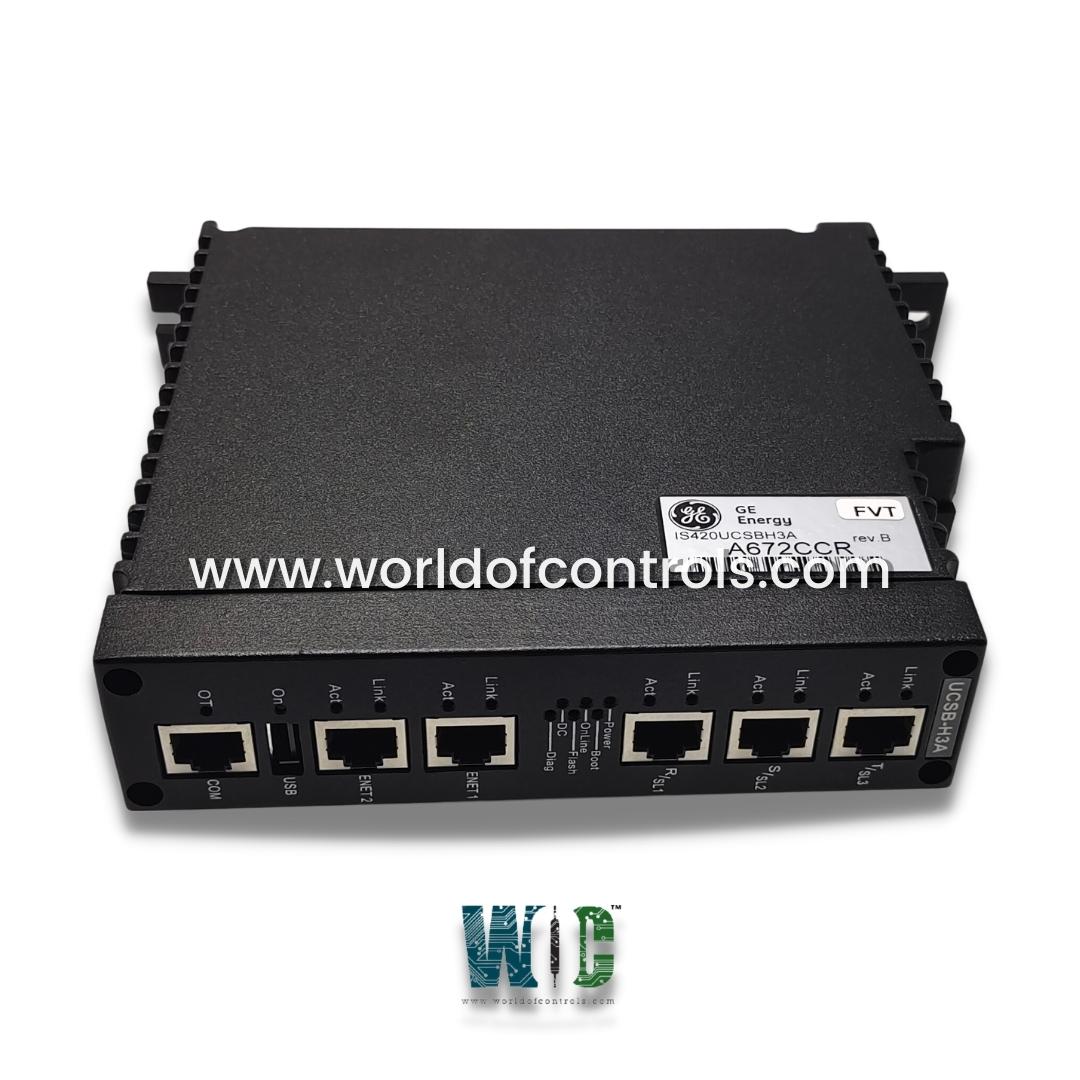
World Of Controls understands the criticality of your requirement and works towards reducing the lead time as much as possible.
IS420UCSBH3A REV D - UCSB Controller Module is available in stock which ships the same day.
IS420UCSBH3A REV D - UCSB Controller Module comes in UNUSED as well as REBUILT condition.
To avail our best deals for IS420UCSBH3A REV D - UCSB Controller Module, contact us and we will get back to you within 24 hours.
SPECIFICATIONS:
Part Number: IS420UCSBH3A REV D
Manufacturer: General Electric
Country of Manufacture: United States (USA)
Series: Mark VIeS
Function: UCSB Controller
Microprocessor; 600MHz Intel
Memory: 256 MB DDR2 SDRAM
Operating System: QNX Neutrino
Programming: Boolean
Primary Ethernet Interface: 10Base-TX/100Base-TX, RJ-45 Connector
Weight: 2.4 lbs
Availability: In Stock
Manual: GEH-6721_Vol_II
FUNCTIONAL DESCRIPTION:
IS420UCSBH3A REV D is a UCSB Controller Module manufactured by General Electric as part of the Mark VIeS Series used in gas turbine control systems with a 1066 MHz Intel EP80579 microprocessor. The UCSB controllers are stand-alone computers that run the application code. The controller mounts in a panel and communicates with the I/O packs through on-board I/O network (IONet) interfaces. IONet is a private special-purpose Ethernet that only supports Mark controls I/O modules and controllers. The controller operating system (OS) is QNX Neutrino, a real-time, multitasking OS designed for high-speed, high-reliability industrial applications. Unlike traditional controllers where I/O is on a backplane, the UCSB controller does not host any application I/O.
Also, all I/O networks are attached to each controller providing them with all input data. The hardware and software architecture guarantees that no single point of application input is lost if a controller is powered down for maintenance or repair. The Mark VIES UCSBH3A Safety Controller and Safety I/O modules are used for functional safety loops to achieve SIL 2 and 3 capabilities. Mark VIES Safety equipment is used by operators knowledgeable in safety-instrumented system (SIS) applications to reduce risk in critical safety functions. Safety controllers and distributed I/O modules are programmed specifically for safety control use, and this specific control hardware and software has IEC 61508 certification. The UCSB controllers offer the following advantages:
UCSB SOFTWARE AND COMMUNICATION:
The controller is loaded with software specific to its application. It can run rungs or blocks. Minor modifications to the control software may be made online without requiring a restart. The IEEE 1588 protocol is used through the R, S, and T IONets to synchronize the clock of the I/O packs and controllers to within ±100 microseconds. External data is transferred to and from the control system database in the controller over the R, S, and T IONets. This includes process inputs/outputs to the I/O modules. In a dual system, this also includes:
UCSB BOOT LED:
The boot LED is lit continuously during the boot process unless an error is detected. If an error is detected, the LED flashes at a 1 Hz frequency. The LED, when flashing, is on for 500 ms and off for 500 ms. After the flashing state, the LED turns off for three seconds. The number of flashes indicates the failed state.
If the flash image is valid but the runtime firmware has not been loaded, the boot LED flashes continuously at a 1 Hz rate. Once the firmware is loaded, the boot LED turns off. If the controller does not go online, use the ToolboxST application to determine why the controller is blocked. Once an IP address has been assigned, the ToolboxST application uses the Ethernet for configuration.
WOC has the largest stock of Replacement parts for GE Distributed Turbine Control Systems. We can also repair your faulty boards and supply unused and rebuilt boards backed up with a warranty. Our team of experts is available round the clock to support your OEM needs. Our team of experts at WOC is happy to assist you with any of your automation requirements. For pricing and availability on parts and repairs, kindly contact our team by phone or email.
How does the UCSB Controller Module synchronize with I/O modules?
The UCSB Controller Module synchronizes with I/O modules using the IEEE 1588 protocol. This advanced synchronization method ensures that the clocks of the I/O packs and controllers remain accurate within 100 microseconds. The synchronization occurs via the R, S, and T IONet networks, allowing for precise timing across the entire control system.
How does the UCSB Controller Module manage communication and network connectivity?
The UCSB Controller Module features multiple network interfaces for redundant and high-speed communication. It utilizes three independent 100Base-TX Ethernet ports (R, S, and T) for connecting to I/O networks using the IONet protocol, ensuring real-time data acquisition and deterministic communication.
What are the hardware specifications of the UCSB Controller Module?
The module features an Intel EP80579 processor, 256 MB DDR2 RAM with ECC, and 2 GB NAND flash storage. It runs on the QNX Neutrino RTOS and includes three 100Base-TX Ethernet ports for redundant network communication.